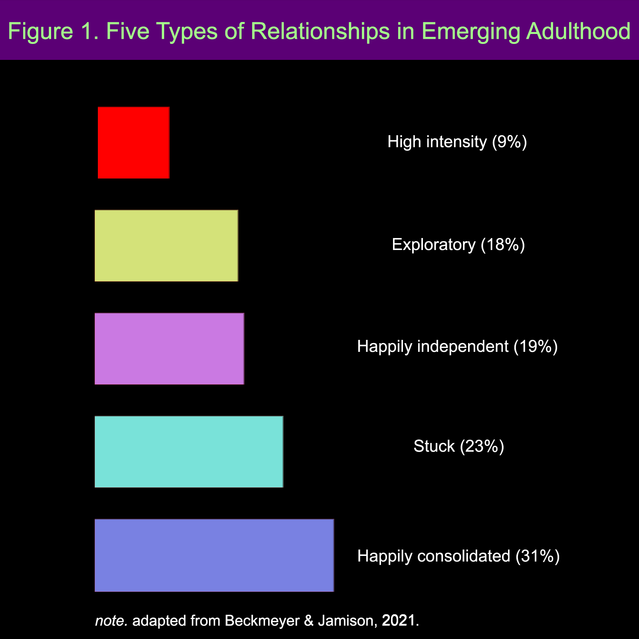Relationships
The 5 Types of Romantic Relationships in Young Adulthood
Research examines romantic relationships in emerging adults.
Posted April 9, 2021 Reviewed by Devon Frye
Key points
- Types of romantic relationships in young adulthood include: happily independent, happily consolidated, exploratory, stuck, and high intensity.
- Young adults in different types of relationships may need help in different areas, like learning how to communicate or build intimacy.
- Partners in high-intensity or stuck relationships may benefit from therapy to address negative intra- and interpersonal dynamics.
Emerging adulthood (ages 18 to 25 years) is an exciting but also confusing and stressful period in the life of a young person. It is characterized by self-focus, optimism, identity exploration, instability, and feeling in-between (i.e. neither an adolescent nor an adult).
An important question regarding emerging adulthood is how the developmental tasks of this period (e.g., financial independence, detachment from family) affect sexual intimacy, relationship commitment, and well-being. For an answer to this question, let us consider a paper by Beckmeyer and Jamison, published in the February issue of Family Relations. These authors identified five types of relationships in young adulthood, which will be described in the sections below.
Study and Methods
The sample consisted of 396 young couples (average age 24 years) in unmarried relationships. Nearly 49 percent were male, 67 percent White, 82 percent heterosexual, and 44 percent with some college education.
The following characteristics were assessed:
- Depressive symptoms
- Life satisfaction
- Heavy drinking
- Relationship duration
- Consolidation (e.g., time spent together, frequency of spending the night)
- Relationship commitment (i.e. likelihood of marriage in the future)
- Relationship experiences, like cohabitation, relationship status, and relationship cycling (i.e. breaking up and reconciling)
- Relationship dynamics (relationship satisfaction, warmth and support, and negative interactions)
- Well-being (i.e. high life satisfaction and absence of depressive symptoms and heavy alcohol use)
The Five Clusters of Romantic Relationships
Using cluster analysis, the researchers identified five romantic relationship clusters (See Figure 1): Happily independent (19 percent), happily consolidated (31 percent), exploratory (18 percent), stuck (23 percent), and high intensity (9 percent).

Happily independent
This group’s characteristics included moderate average relationship duration (1.7 years), high perceived probability of marriage, low levels of negative interactions, and high satisfaction, support, and warmth.
None of the members were cohabiting, though 83 percent were in an exclusive relationship. They had a relatively low level of consolidation (e.g., spending little time together), perhaps because more consolidation would have been difficult (nearly half were students). Alternatively, they might have wanted to keep their options open as they developed other aspects of their lives (e.g., work, education).
Happily consolidated (the largest group)
Commitment and relationship dynamics in this sample resembled those of the happily independent couples, with the major differences being a longer average duration (3.4 years) and more consolidation (e.g., spending more time together). This cluster featured the smallest proportion of casual daters (2 percent), but the biggest proportion of those engaged (29 percent).
The level of well-being of the happily consolidated couples also resembled that of the happily independent couples, which suggests both groups had learned to balance their professional activities and romantic engagement in an optimal way.
It is possible the member of the happily independent cluster transition to this cluster, over time.
Exploratory
This group had the shortest relationship duration and the lowest level of commitment and consolidation. Compared to the two groups above, it was characterized by lower warmth/support and satisfaction, and more negative interactions.
Not surprisingly, most couples (62 percent) were casually dating, perhaps trying to determine the long-term potential of their relationships. It is not clear how these relationships would change over time (e.g., breakups vs. greater consolidation).
Stuck
Characteristics included the longest relationship duration (3.5 years), high consolidation, moderate commitment, high depressive symptoms, and low relationship satisfaction, warmth, and support. Roughly 70 percent were cohabiting, 19 percent were engaged, and 59 percent were in exclusive relationships.
Young adults in stuck relationships are perhaps either not sure about the direction of their relationship or are using their romantic relationship as a way to bring stability to their lives. Nevertheless, nearly 55 percent reported relationship cycling (i.e. breaking up and getting back together), which may indicate eventual relationship dissolution and breakup.
High intensity (the smallest group)
A moderately high degree of support, warmth, and satisfaction, but also the highest degree of negative interactions characterized the high-intensity cluster. Though couples in high-intensity relationships were quite committed and consolidated, they had the highest level of relationship cycling (57 percent).
One way to explain these contradictory patterns is to see high-intensity romantic couples as optimistic about the future, despite considerable current problems. Alternatively, they might believe their negative interactions are balanced by the warmth and support inherent to their relationships; then again, this cluster reported more depressive symptoms than others.

Guidance for Different Romantic Relationship Types
As noted in the introduction, young adulthood can be quite stressful and confusing. Indeed, one of the goals of the paper reviewed was to determine how to best guide and help young couples as they attempt to complete the developmental tasks of this period (e.g., becoming independent, committing to an intimate relationship).
The authors suggest that, depending on their cluster, young adults in romantic relationships require different types of help:
Those in the happily independent or consolidated groups could benefit from supportive programs focused on building intimacy, conflict resolution, and planning for the future (e.g., planning for marriage).
Young couples in exploratory relationships will need assistance with deciding their level of commitment and consolidation. The goal is to be able to make more deliberate decisions regarding issues such as cohabitation before such decisions become complicated by factors like having a child together.
If they come to realize their relationship has serious long-term potential, young couples might benefit from learning how to communicate their expectations and relational goals. If, in contrast, they realize their relationship is not meeting their needs, they will require assistance with deciding when and how to end things.
Last, young adults in high-intensity or stuck clusters may need not only education and resources but also therapy to address their dysfunctional relationship patterns.
Facebook image: DavideAngelini/Shutterstock




